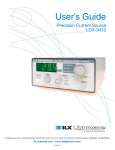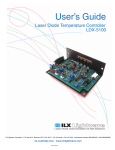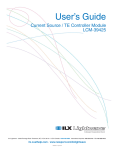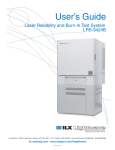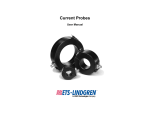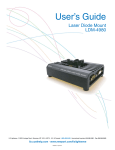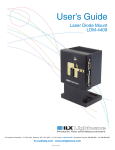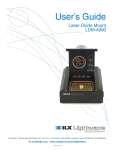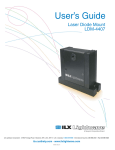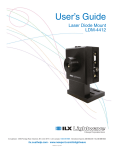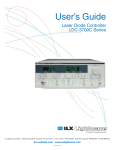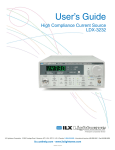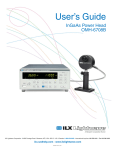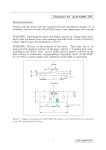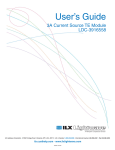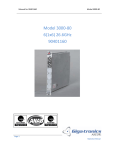Download LDX-3412 Precision Laser Diode Driver Manual
Transcript
User’s Guide Precision Current Source LDX-3412 ILX Lightwave Corporation · P. O. Box 6310 · Bozeman, MT, U.S.A. 59771 · U.S. & Canada: 1-800-459-9459 · International Inquiries: 406-586-1244 · Fax 406-586-9405 E-mail: [email protected] www.ilxlightwave.com 70001304_R00_01/04 TABLE OF CONTENTS Safety and Warranty Information . . . . . . . . . . . . . . . . . . . . . . . . . . . . . . . . . . . . iii Safety Information and the Manual . . . . . . . . . . . . . . . . . . . . . . . . . . . . . . . . . iii General Safety Considerations . . . . . . . . . . . . . . . . . . . . . . . . . . . . . . . . . . . . iii Safety Symbols. . . . . . . . . . . . . . . . . . . . . . . . . . . . . . . . . . . . . . . . . . . . . . . . . . iv Safety Marking Symbols . . . . . . . . . . . . . . . . . . . . . . . . . . . . . . . . . . . . . . . . . iv Warranty . . . . . . . . . . . . . . . . . . . . . . . . . . . . . . . . . . . . . . . . . . . . . . . . . . . . . . . . v Limitations . . . . . . . . . . . . . . . . . . . . . . . . . . . . . . . . . . . . . . . . . . . . . . . . v Returning an Instrument . . . . . . . . . . . . . . . . . . . . . . . . . . . . . . . . . . . . . . v Claims for Shipping Damage . . . . . . . . . . . . . . . . . . . . . . . . . . . . . . . . . . v Comments, Suggestions, and Problems . . . . . . . . . . . . . . . . . . . . . . . . . . . . vi Chapter 1 General Information Product Overview . . . . . . . . . . . . . . . . . . . . . . . . . . . . . . . . . . . . . . . . . . . . . . . . 1 Specifications . . . . . . . . . . . . . . . . . . . . . . . . . . . . . . . . . . . . . . . . . . . . . . . . . 2 Your Comments . . . . . . . . . . . . . . . . . . . . . . . . . . . . . . . . . . . . . . . . . . . . . . . 2 Chapter 2 Operation Installation . . . . . . . . . . . . . . . . . . . . . . . . . . . . . . . . . . . . . . . . . . . . . . . . . . . . . . 3 AC Power Considerations . . . . . . . . . . . . . . . . . . . . . . . . . . . . . . . . . . . . . . 3 LDX-3412 Familiarization . . . . . . . . . . . . . . . . . . . . . . . . . . . . . . . . . . . . . . . . Front Panel . . . . . . . . . . . . . . . . . . . . . . . . . . . . . . . . . . . . . . . . . . . . . . . . . Power-up Sequence . . . . . . . . . . . . . . . . . . . . . . . . . . . . . . . . . . . . . . . . . . Operating MODE Selection . . . . . . . . . . . . . . . . . . . . . . . . . . . . . . . . . . . . . Current LIMIT Adjustment . . . . . . . . . . . . . . . . . . . . . . . . . . . . . . . . . . . . . . Output Current Adjustment . . . . . . . . . . . . . . . . . . . . . . . . . . . . . . . . . . . . . OUTPUT Off/On Switch . . . . . . . . . . . . . . . . . . . . . . . . . . . . . . . . . . . . . . . . Fault Indicators . . . . . . . . . . . . . . . . . . . . . . . . . . . . . . . . . . . . . . . . . . . . . . Rear Panel . . . . . . . . . . . . . . . . . . . . . . . . . . . . . . . . . . . . . . . . . . . . . . . . . . Output Connectors . . . . . . . . . . . . . . . . . . . . . . . . . . . . . . . . . . . . . . . . . . . . 3 4 4 4 4 4 5 5 5 6 LDX-3412 i TA B L E O F C O N T E N T S Chassis GND Connector . . . . . . . . . . . . . . . . . . . . . . . . . . . . . . . . . . . . . . . 6 Photodiode Feedback (PD) GAIN Adjustment . . . . . . . . . . . . . . . . . . . . . . . 7 Warm-up and Environmental Considerations . . . . . . . . . . . . . . . . . . . . . . . . . 7 Operating Instructions . . . . . . . . . . . . . . . . . . . . . . . . . . . . . . . . . . . . . . . . . . . Connecting to Your Device . . . . . . . . . . . . . . . . . . . . . . . . . . . . . . . . . . . . . System Interlock . . . . . . . . . . . . . . . . . . . . . . . . . . . . . . . . . . . . . . . . . . . . . Photodiode Feedback Connections . . . . . . . . . . . . . . . . . . . . . . . . . . . . . . . Laser Diode Connections and Shielding . . . . . . . . . . . . . . . . . . . . . . . . . . . Grounding Considerations . . . . . . . . . . . . . . . . . . . . . . . . . . . . . . . . . . . . . . General Operating Procedure . . . . . . . . . . . . . . . . . . . . . . . . . . . . . . . . . . . Chapter 3 7 7 7 7 9 9 9 Troubleshooting Troubleshooting . . . . . . . . . . . . . . . . . . . . . . . . . . . . . . . . . . . . . . . . . . . . . . . . 11 ii LDX-3412 SAFETY AND WARRANTY INFORMATION The Safety and Warranty Information section provides details about cautionary symbols used in the manual, safety markings used on the instrument, and information about the Warranty including Customer Service contact information. Safety Information and the Manual Throughout this manual, you will see the words Caution and Warning indicating potentially dangerous or hazardous situations which, if not avoided, could result in death, serious or minor injury, or damage to the product. Specifically: ! CAUTION Caution indicates a potentially hazardous situation which can result in minor or moderate injury or damage to the product or equipment. WARNING Warning indicates a potentially dangerous situation which can result in serious injury or death. WARNING Visible and/or invisible laser radiation. Avoid direct exposure to the beam. General Safety Considerations If any of the following conditions exist, or are even suspected, do not use the instrument until safe operation can be verified by trained service personnel: • Visible damage • Severe transport stress • Prolonged storage under adverse conditions • Failure to perform intended measurements or functions If necessary, return the instrument to ILX Lightwave, or authorized local ILX Lightwave distributor, for service or repair to ensure that safety features are maintained (see the contact information on page vii). All instruments returned to ILX Lightwave are required to have a Return Authorization Number assigned by an official representative of ILX Lightwave Corporation. See Returning an Instrument on page v for more information. Safety and Warranty Information iii SAFETY SYMBOLS SAFETY SYMBOLS This section describes the safety symbols and classifications. Technical specifications including electrical ratings and weight are included within the manual. See the Table of Contents to locate the specifications and other product information. The following classifications are standard across all ILX Lightwave products: • Indoor use only • Ordinary Protection: This product is NOT protected against the harmful ingress of moisture. • Class I Equipment (grounded type) • Mains supply voltage fluctuations are not to exceed ±10% of the nominal supply voltage. • Pollution Degree II • Installation (overvoltage) Category II for transient overvoltages • Maximum Relative Humidity: <80% RH, non-condensing • Operating temperature range of 0 ×C to 40 ×C • Storage and transportation temperature of ñ40 ×C to 70 ×C • Maximum altitude: 3000 m (9843 ft) • This equipment is suitable for continuous operation. Safety Marking Symbols This section provides a description of the safety marking symbols that appear on the instrument. These symbols provide information about potentially dangerous situations which can result in death, injury, or damage to the instrument and other components. or (I) iv Caution, refer to manual Earth ground Terminal Alternating current Visible and/or invisible laser radiation Caution, risk of electric shock Protective Conductor Terminal Caution, hot surface Frame or chassis Terminal On: In position of a bistable push control. The slash (I) only denotes that mains are on. Safety and Warranty Information or (O) Off: Out position of a bistable push control. The circle (O) only denotes that mains are off. WA R R A N T Y WARRANTY ILX LIGHTWAVE CORPORATION warrants this instrument to be free from defects in material and workmanship for a period of one year from date of shipment. During the warranty period, ILX will repair or replace the unit, at our option, without charge. Limitations This warranty does not apply to fuses, lamps, defects caused by abuse, modifications, or to use of the product for which it was not intended. This warranty is in lieu of all other warranties, expressed or implied, including any implied warranty of merchantability or fitness for any particular purpose. ILX Lightwave Corporation shall not be liable for any incidental, special, or consequential damages. If a problem occurs, please contact ILX Lightwave Corporation with the instrument's serial number, and thoroughly describe the nature of the problem. Returning an Instrument If an instrument is to be shipped to ILX Lightwave for repair or service, be sure to: 1 Obtain a Return Authorization number (RA) from ILX Customer Service. 2 Attach a tag to the instrument identifying the owner and indicating the required service or repair. Include the instrument serial number from the rear panel of the instrument. 3 Attach the anti-static protective caps that were shipped with the instrument and place the instrument in a protective anti-static bag. 4 Place the instrument in the original packing container with at least 3 inches (7. 5 cm) of compressible packaging material. Shipping damage is not covered by this warranty. 5 Secure the packing box with fiber reinforced strapping tape or metal bands. 6 Send the instrument, transportation pre-paid, to ILX Lightwave. Clearly write the return authorization number on the outside of the box and on the shipping paperwork. ILX Lightwave recommends you insure the shipment. If the original shipping container is not available, place your instrument in a container with at least 3 inches (7.5 cm) of compressible packaging material on all sides. Repairs are made and the instrument returned transportation pre-paid. Repairs are warranted for the remainder of the original warranty or for 90 days, whichever is greater. Safety and Warranty Information v WA R R A N T Y Claims for Shipping Damage When you receive the instrument, inspect it immediately for any damage or shortages on the packing list. If the instrument is damaged, file a claim with the carrier. The factory will supply you with a quotation for estimated costs of repair. You must negotiate and settle with the carrier for the amount of damage. vi Safety and Warranty Information WA R R A N T Y Comments, Suggestions, and Problems To ensure that you get the most out of your ILX Lightwave product, we ask that you direct any product operation or service related questions or comments to ILX Lightwave Customer Support. You may contact us in whatever way is most convenient: Phone . . . . . . . . . . . . . . . . . . . . . . . . . . . (800) 459−9459 or (406) 586−1244 Fax . . . . . . . . . . . . . . . . . . . . . . . . . . . . . . . . . . . . . . . . . . . . . (406) 586−9405 Email. . . . . . . . . . . . . . . . . . . . . . . . . . . . . . . . . . . . [email protected] Or mail to: ILX Lightwave Corporation P. O. Box 6310 Bozeman, Montana, U.S.A 59771 www.ilxlightwave.com When you contact us, please have the following information: Model Number: Serial Number: End−user Name: Company: Phone: Fax: Description or sketch of what is connected to the ILX Lightwave instrument: Description of the problem: If ILX Lightwave determines that a return to the factory is necessary, you are issued a Return Authorization (RA) number. Please mark this number on the outside of the shipping box. You or your shipping service are responsible for any shipping damage when returning the instrument to ILX Lightwave; ILX recommends you insure the shipment. If the original shipping container is not available, place your instrument Safety and Warranty Information vii WA R R A N T Y in a container with at least 3 inches (7.5cm) of compressible packaging material on all sides. We look forward to serving you even better in the future! viii Safety and Warranty Information CHAPTER 1 GENERAL INFORMATION This manual contains operation and maintenance information for the LDX-3412 Precision Current Source. Appendix A contains a brief troubleshooting guide. Product Overview The LDX-3412 is an easy to operate, precision current source. It is optimized for driving laser diodes and LEDs with an output range of 0 to 200 mA, with a compliance voltage of >6 volts. Multiple built-in protection features ensure that the supply output is transient-free and bounded under all conditions. There are three modes of operation for the LDX-3412: (1) Constant Power, which allows photodiode feedback to control the output current; (2) Constant Current, in which feedback from the laser is used to control the output current; and (3) Limit Display, in which the current limit is displayed while the output current is off. Features of the LDX-3412 include: • Intuitive front panel layout • Fully independent, precision current limit control • Slow turn-on circuit for laser diode protection • Safe OUTPUT off/on switch • Double shielded transformers for low noise • Photodiode feedback capability LDX-3412 1 CHAPTER 1 GENERAL INFORMATION Product Overview Specifications OUTPUT1 Current Range: 0 to 200 mA, floating Compliance Voltage: >6 Volts Temperature coefficient: <100 ppm/oC, ambient Stability, 10-30 min.: <50 ppm Noise and ripple (at 100 mA): <10 µA rms Transients: <100 µA DISPLAY Type: 3-1/2 digit green LED Max Reading: 199.9 mA Accuracy at 25 ×C: +0.2 mA CURRENT LIMIT Range: 1-200 mA Accuracy: +3 mA PHOTODIODE FEEDBACK Input type: Current input from external photodiode Range: 20 µA to 2 mA Stability: +0.1% GENERAL 1. AC Power: 100, 120, 220, 240 nominal line voltage, ±10%, 50-60 Hz Operating Temperature: 0 oC to 40 oC Storage Temperature: -40 oC to 70 oC Warm-up: 1 hour for rated accuracy Laser Output Connector: 9-pin D-sub Chassis Ground: Standard banana jack Overall Size: 267 x 140 x 66 mm (10.5 x 5.5 x 2.6 inches) The instrument contains a circuit that turns off the output if a transient is detected. Your Comments Our goal is to make the best laser diode instrumentation available anywhere. To achieve this, we need your ideas and comments on ways we can improve our products. We invite you to contact us at any time with your suggestions. 2 LDX-3412 CHAPTER 2 OPERATION This chapter is a guide to setting up and operating the LDX-3412. The controls and connectors are described, and then step-by-step instructions for connecting and using the LDX-3412 are presented. Installation Before plugging in the LDX-3412 to your AC power source, AC Power Considerations . After power-up, make sure that the OUTPUT is off (LED unlit). For operating procedure, see Operating Instructions on page 7. AC Power Considerations The LDX-3412 can be configured for operation with nominal line voltages of 100, 120, 220, and 240 VAC. The unit is configured at the factory for the appropriate range. Make sure the AC input power matches the range marked on the rear panel. To avoid electrical shock hazard, connect the instrument to properly earth-grounded electical supply only. Failure to observe this precaution can result in severe injury or death. LDX-3412 Familiarization The following sections are provided to familiarize the user with features found on the LDX-3412. LDX-3412 3 CHAPTER 2 OPERATION Installation Front Panel The LDX-3412 front panel is shown in Figure 2.1. Figure 2.1 LDX-3412 Front Panel Power-up Sequence With the LDX-3412 properly connected to an AC power source, pressing the AC POWER off/on switch causes the unit to initiate its power-up sequence. During this period the output terminals are unconditionally shorted and the OUTPUT off/on switch is inhibited for two seconds. This is done to prevent transients from reaching your laser diode. Operating MODE Selection The MODE select switch allows the user to select between the three modes of operation by turning the MODE knob to the desired mode. CONST P selects constant power mode for photodiode feedback control. CONST I selects constant current mode for normal operation. LIMIT DISPLAY selects a display mode in which the output is turned off and the current LIMIT is displayed on the LED display. When the MODE select switch is turned between modes, the output is turned off. Current LIMIT Adjustment The current LIMIT knob allows the user to set the upper limit on output current. The user may adjust the output current from zero (LIMIT knob fully counterclockwise CCW) to 200 mA (LIMIT knob fully clockwise CW). This LIMIT knob is recessed to prevent accidental readjustment of the output current during operation. 4 LDX-3412 OPERATION Installation CHAPTER 2 Under all modes of operation the output current is unconditionally limited to the value set by the LIMIT adjustment. Output Current Adjustment The output current adjustment knob is located in the top right-hand corner of the front panel. Turning this knob clockwise (CW) will increase the output current. The output current will be displayed on the LED display during CONST P or CONST I operation. OUTPUT Off/On Switch The OUTPUT off/on switch is located in the lower right-hand corner of the front panel. This switch has a toggling action which turns the output current of the LDX-3412 on and off. When the output is active, the LED indicator just above the switch will be lit. When the output is off, a low impedance shunt is activated across the output terminals. In this state it is safe to connect or disconnect sensitive devices from the LDX-3412, even though the power supply itself is on. When the LDX-3412 is first turned on, the OUTPUT off/on switch is inhibited for several seconds. This forces the internal, low impedance shunt to remain active across the output terminals until the LDX-3412 control circuits are stabilized. Additionally, there are four other conditions which will automatically cause the output to reset to the off state: • Power Drop-outs - AC line power drop-outs lasting more than about 10 msec will trigger an internal power monitor and cause the output to switch unconditionally to the off state. This sequence is also initiated when the LDX-3412 is switched off or unplugged. • Open Circuit - If the compliance voltage of the externally connected circuit exceeds about 6 volts, the output is switched to the off state and the OPEN CKT indicator is activated. Most commonly this occurs when the OUTPUT off/on switch is pressed without a load attached. • Mode Changes - Changing the position of the MODE selector switch resets the output to the off state. • Interlock - If the interlock circuit is broken, the output is reset to the off state. If any of these conditions occur, the output may be turned on again by simply pressing the OUTPUT off/on switch, after corrective action is taken (if needed). Fault Indicators The LDX-3412 has two visual front panel fault indicators, OPEN CKT and LIMIT. • OPEN CKT - indicates that the compliance voltage required at the LDX-3412 output terminals has exceeded approximately 6 volts. Most commonly this happens when there is no load attached to the output or the load becomes disconnected when the output is active. When an OPEN CKT condition occurs, the LDX-3412 output is automatically turned off and 01_04 LDX-3412 5 CHAPTER 2 OPERATION Installation the OPEN CKT indicator latches on. The OPEN CKT indicator will remain on until the output is manually turned on again. • LIMIT - indicates that the LDX-3412 output is being limited to the setting of the front panel LIMIT knob. When a LIMIT condition occurs, the LIMIT indicator becomes lit. The LIMIT DISPLAY indicator is not a fault indicator. It is lit when the unit is operated in the LIMIT DISPLAY mode. This is done to remind the user that LIMIT DISPLAY mode is in operation and the OUTPUT switch is inactive. Rear Panel The rear panel contains the 9-pin D-sub connector, chassis ground post, photodiode gain adjustment controls, power cord receptacle, and serial number sticker. . Figure 2.2 LDX-3412 Rear Panel 1, 2 3 4, 5 6 7 8, 9 Interlock Chassis Ground Laser Cathode PD Cathode (+) PD Anode (-) Laser Anode 1 2 6 7 3 4 8 9 5 Figure 2.3 D-connector (J105) Pinout 6 LDX-3412 OPERATION Installation CHAPTER 2 Output Connectors Output current is available from the 9-pin D-sub connector (J105). Pins 4 and 5 are the negative output, and pins 8 and 9 are the positive output current connections. These pins are jumpered to provide greater contact area for the output connections. This is done to reduce the risk of an open output connection due to a loose connector. Thus, the output is made safer for laser diodes. Note: Whenever external connections are made to the output at pins 4 and 5 and 8 and 9. These connector leads must be jumpered as shown above to ensure the greatest laser diode safety. Chassis GND Connector The output current terminals are floating with respect to chassis ground. A chassis ground GND connector (bare metal) is available for the user's convenience. See Section 2.5.4, Laser Diode Connections and Shielding. Photodiode Feedback (PD) GAIN Adjustment Photodiode feedback gain may be adjusted by the user via the COARSE and FINE controls on the rear panel of the LDX-3412. When the CONST P mode is selected, the user may adjust the feedback gain for proper testing of a laser diode. Turning the COARSE and FINE controls counter-clockwise (CCW) will increase the feedback gain and decrease the output current. See Figure 2.4 for setting the photodiode feedback gain. Warm-up and Environmental Considerations The LDX-3412 should be operated at an ambient temperature between 0 and 50 oC. Storage temperatures should be in the range of -40 oC to 70 oC. In order to achieve rated accuracy, the LDX-3412 should be warmed up for 1 hour before use. Note: To prevent overheating, the LDX-3412 must be kept well ventilated. Allow at least 1/2 inch clearance around the vent holes. Operating Instructions The following sections contain instructions on the set-up and operation of the LDX-3412. Section 2.5.6 contains the step-by-step operating procedures. For calibration, see Section 4.2. Connecting to Your Device When connecting laser diodes and other sensitive devices to the LDX-3412, we recommend that the LDX-3412 be powered up and the OUTPUT be off (LED unlit). In this condition a low impedance shunt is active across the output 01_04 LDX-3412 7 CHAPTER 2 OPERATION Installation terminals. When disconnecting devices, it is only necessary to turn the OUTPUT off. System Interlock When the LDX-3412 is shipped, an interlock is incorporated at connector J105 (pins 1 and 2). Output current will not flow unless there is an electrical connection made between pins 1 and 2 of J105. When the interlock function is to be used, the user must provide a normally closed switch or relay across pins 1 and 2 of the 9-pin connector (J105). The switch must be electrically isolated from all other circuits, including earth ground. Photodiode Feedback Connections The 9-pin connector J105 (see pinout, Figure 2.3) on the rear panel contains the current supply output and earth ground. The photodiode feedback signal is input at the connector at pins 6 and 7. Many laser diode modules contain an internal photodiode that monitors the backfacet emission of the laser. This photodiode is usually internally connected to either the laser anode or cathode. Figures 2.5 A - D show the recommended connections and shielding for the various configurations of laser diode modules and photodiode feedback schemes. The feedback photodiode reverse-biasing supply shown in these figures must be supplied by the user. You must locate this supply where it won't cause the common mode voltage of the feedback inputs to exceed the specified maximum of +6 V, relative to the "-" current output (J105, pins 4,5). Noise from this biasing supply may contribute to the output noise levels; therefore, a battery with shielded connections is recommended. Module OUTPUT 7 + 6 Bias + 9 5 P. D. L. D. 3 Earth Ground Figure 2.4 Common Laser Cathode - Photodiode Cathode 8 LDX-3412 OPERATION Installation CHAPTER 2 Module OUTPUT 7 + 6 Bias + 9 5 P. D. 3 L. D. Earth Ground Figure 2.5 Common Laser Cathode - Photodiode Anode Module OUTPUT 7 + 6 Bias + 9 5 P. D. 3 L. D. Earth Ground Figure 2.6 Common Laser Anode - Photodiode Cathode Module OUTPUT 7 + 6 Bias + 9 5 P. D. L. D. 3 Earth Ground Figure 2.7 Common Laser Anode - Photodiode Anode If a feedback photodiode is used which is electrically isolated from the laser, the feedback circuit must be resistively "tied" at some point to the output circuit. A large resistance of 1 Mohm, connected from the laser cathode to the photodiode anode, may be used in place of the direct connection. This is done to keep the feedback inputs within the specified maximum +6 volt common mode voltage, relative to the "-" laser current output terminal. The circuit of Figure 2.5 should be used, if feasible. 01_04 LDX-3412 9 CHAPTER OPERATION Installation 2 Laser Diode Connections and Shielding Before connecting the laser diode to the LDX-3412, be sure that the front panel OUTPUT switch is in the OFF position (LED unlit). Before turning on the OUTPUT, be sure that the current LIMIT has been correctly set. The LDX-3412 output is available through the 9-pin rear panel connector (J105). The LDX-3412 sources current through pins 8 and 9 to the laser anode (+) and returns current from cathode (-) through pins 4 and 5. It is recommended that the connections to the LDX-3412 output be made using twisted wire pairs with an earth-grounded shield (see Figures 2.4-2.7). The output conductors are left floating relative to earth ground to suppress AC poweron/power-off transients that may occur through an earth-ground path. If the output circuit is earth-grounded at some point (such as through the laser package and mount), the user must be careful to avoid multiple earth grounds in the circuit. Multiple earth grounds may provide circuit paths that induce spurious currents in the photodiode feedback circuit and output leads. Grounding Considerations The outputs of the LDX-3412 are isolated from chassis ground allowing either output terminal to be grounded at the user's option. Figures 2.4 - 2.7 show the proper earth-ground shielding for the most common laser diode/photodiode connections. General Operating Procedure The LDX-3412 can be operated in several modes. The following operating procedure is applicable to most common usage. 10 LDX-3412 1 Plug the LDX-3412 into a properly grounded, three-terminal AC power source which supplies the correct voltage and frequency for your unit. 2 Turn on the LDX-3412; allow a one hour warm-up period for rated accuracy operation. 3 Select the LIMIT DISPLAY MODE and adjust the LIMIT knob to the maximum current that you wish to source. 4 Select the desired MODE of operation. 5 With the OUTPUT off (LED unlit), make the necessary external circuit connections. Double check to ensure that the correct polarity has been observed when connecting to laser diodes or other devices which are sensitive to being reversed biased. For proper photodiode feedback connections, refer to Section 2.5.3. 6 If the CONST P mode is selected, turn the COARSE and FINE PD GAIN pots fully counter-clockwise (CCW). This will initially maximize the feedback gain and minimize the OPERATION Installation CHAPTER 2 output current to the laser. 7 Switch the OUTPUT on (LED lit), and adjust the current to the desired DC level using the main current setting knob. Note: If there is no output current at this point, check to be sure that the proper interlock connections have been made. If the interlock is enabled, Pins 1 and 2 of J105 must be electrically connected before output current will flow. In order to find the proper photodiode feedback gain for your laser (in CONST P mode), it will be necessary to follow these additional steps: 8 With the output on, slowly turn the FINE control clockwise (CW) until the proper feedback is reached. Turning the GAIN controls clockwise (CW) will increase the output current. If the FINE control is turned fully clockwise but the proper gain has not been reached, continue with Step 9. 9 Reset the FINE control to its fully counter-clockwise (CCW) position. Next, slowly turn the COARSE control clockwise (CW) about 1/4 turn. If the LIMIT LED becomes lit, turn the COARSE control back down (CCW) a bit. Then repeat Steps 8 and 9 as necessary. Note: At any time during the operation of the LDX-3412, the output current limit setting may be observed by selecting LIMIT DISPLAY mode. In this mode, the output current will be off and the current limit setting will be displayed on the LED display. 01_04 LDX-3412 11 CHAPTER 12 LDX-3412 2 OPERATION Installation CHAPTER 3 TROUBLESHOOTING Calibration and line Voltage Selection require opening the case and exposure to potentially lethal voltages. These procedures are to be performed by qualified service personnel only. Consult the factory for service instructions. ILX Lightwave provides in-house and on-site calibration services for ILX instruments. Most ILX instruments require yearly calibration to ensure performance to published specifications. ILX factory calibrations employ NIST traceable measurement instrumentation, and our calibration engineers and technicians use automated test equipment to accurately and efficiently capture and record calibration data. An original certificate of calibration authenticity is provided with all instrument calibrations, and a detailed report showing any precalibration out-of-tolerance conditions is available upon request. Calibration turntimes are normally five business days or less. On-site calibrations can be performed around your production schedule, night or day, seven days a week. Please contact ILX Customer Support (see page xi for contact information) for additional calibration information. Troubleshooting This appendix is a guide to troubleshooting the LDX-3412. Some of the more common symptoms are listed here, and the appropriate troubleshooting actions are given. We recommend that the user start at the beginning of this guide. Read the symptom descriptions, and follow the steps for the corrective actions which apply. If you encounter problems which are beyond the scope of this troubleshooting guide, contact ILX Lightwave at the number listed at the front of LDX-3412 11 CHAPTER 3 TROUBLESHOOTING Troubleshooting this manual. Our Service Engineers will be glad to answer any questions concerning this or any other ILX Lightwave product.. Table 3.1 Troubleshooting Symptoms and Actions SYMPTOM CORRECTIVE ACTIONS LDX-3412 will not power up. • Check AC Power line voltage and power cord connection. LDX-3412 powers up, but there is no current OUTPUT. • Check the MODE switch. Output will only be on while in CONST I or CONST P modes. • Check the interlock feature. If interlock is enabled, there must be a short between pins 1 and 2 of J105 to have output. • Check the OUTPUT switch. The LED should be lit. • Check the OPEN CKTindicator. If it is lit, there is an open in the output circuit. • Check the current output control knob. Set it fully counter-clockwise (CCW) for minimum output. • If CONST P mode is used, check the feedback gain setting (Section 2.3.11). Try turning the feedback GAIN controls down (CCW). • If CONST P mode is used, check the feedback connections. Try reversing the polarity of the photodiode. • Check the interlock circuit. A broken circuit will reset the LDX-3412 to the off state. • Check that the AC power cord connection is secure. Power drop-outs may turn the OUTPUT off. • Check the AC line cord to make sure that it is well-connected. Output current at limit, cannot be lowered OUTPUT intermittently turns off during operation. 12 LDX-3412
























